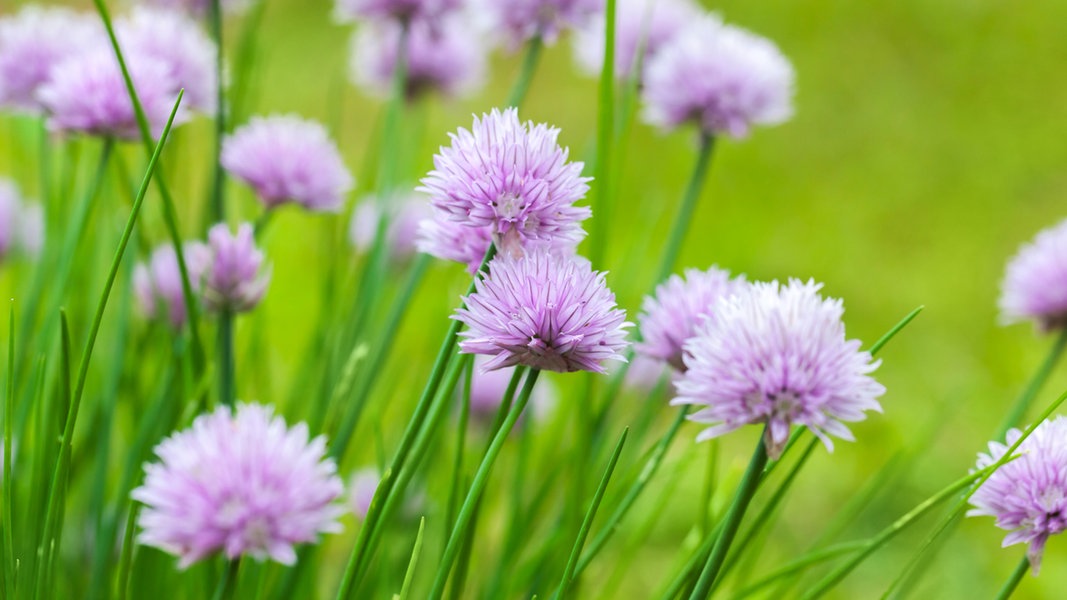As of: February 24, 2024 5:00 a.m
Whether in a pot or in the herb garden: chives are a popular perennial herb. Anyone who would like to sow it outdoors can do so from April. Sowing indoors is possible from February. Â
In addition to parsley, there are chives (Allium schoenoprasum) one of the most popular and well-known culinary herbs. The tube leaves of the local plant are popular for refining salads, soups or scrambled eggs. Growing chives in the garden is basically uncomplicated. Thanks to its pretty flowers in purple, pink or white, it is also an eye-catcher in the bed and a good source of food for bees and other insects.
The right location and suitable plant neighbors
Chives are perennial and hardy plants.
Chives require a sunny to partially shaded location. The garden soil should be moderately moist, permeable, rather calcareous and rich in nutrients. When planting or sowing, it is best to add compost directly and, if the soil is heavy, to also work some sand into the soil. Good plant neighbors – for example in a herb spiral – are chamomile, thyme, sage, peppermint and tarragon. In the vegetable patch, chives grow well in a mixed culture alongside carrots, strawberries and cucumbers.
Downloads
Mixed cultures strengthen plants. A printable list of good and bad neighbor plants. Download (96 KB)
Sowing chives: This is how it works
In contrast to many other plants, chive seeds can only germinate for a short time, namely around a year. Therefore, when buying seeds, always pay attention to fresh goods. To germinate, chives need temperatures between around 15 and a maximum of 20 degrees; if in doubt, it should be a little cooler rather than too warm. If you would like to use the herb indoors, you can do so from February. The seeds germinate after about 14 days. Depending on the variety, sowing outdoors is recommended between April and August. Early chives can also be planted in the bed from April.
Thoroughly clear the soil of weeds
The pretty chive flowers are edible and serve as food for insects.
Chives grow rather slowly and can therefore quickly be overgrown by weeds in the bed. For successful sowing, it is therefore important to thoroughly remove weeds and loosen up the garden soil before sowing. Since the chive seeds are very fine, they are easiest to sow if the seeds are mixed with a little sand.
The seeds should ideally be 30 centimeters apart, this applies to both the row spacing and the planting spacing. Chives are dark germinators and must be covered with a one to two centimeter layer of soil. After sowing, water the soil and keep it moist. Always make sure that there are as few weeds as possible, especially during the growth phase. The soil must never dry out.
Alternative: Multiply chives by dividing them
Since growing chives from seeds in a pot or in a bed is not that easy, there are simple alternatives. If you want to be on the safe side, buy an early plant or propagate an existing one by division. To do this, dig up the plant and use a sharp knife or spade to divide the root ball into several pieces and replant them. Chives can be divided about every two to three years; the measure is also a rejuvenation treatment for the plant.
Cut and harvest chives
To harvest chives, cut the stalks two centimeters above the ground.
The first harvest can take place about six weeks after sowing. The stalks should be at least 15 centimeters high and not yet bear any flowers. Although the flowers are edible, the tubes are less tasty and can become bitter and solid. The cut is about two centimeters above the ground, preferably with a clean and sharp knife. A warm and dry morning is best for harvesting, so the essential oils are preserved and the chives have the best taste. If you want to do something for nature conservation, simply let some of the stalks grow so that insects can use the flowers as food.
The flowers of chives are edible and taste slightly sweet. However, as the flowers form, the taste of the stalks diminishes and they then become very firm and rather bitter.
Chives overwinter in the bed without any problems. If you want to harvest the spice in winter, dig up the plant in autumn, plant it in a pot and take it into the house.
Further information
When is the best time to prefer tomatoes, when are cucumbers? An overview and tips for sowing. more
Carrot, cabbage or lettuce: For many vegetables there is an optimal period for sowing. A sowing calendar. more
Herbs in the garden or on the balcony need different locations. What do parsley, rosemary, etc. need? more
Fresh herbs such as basil, dill and parsley are essential in the kitchen and should not be missing in any garden. What should be taken into account when selecting a location and maintaining it? more
This topic in the program:
NDR 1 Lower Saxony | Oct 25, 2023 | 7:00 p.m
